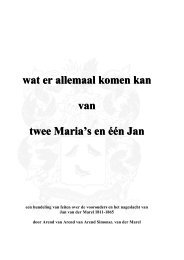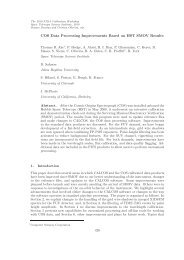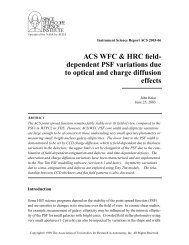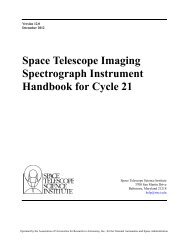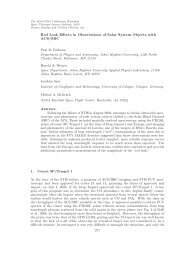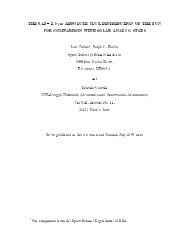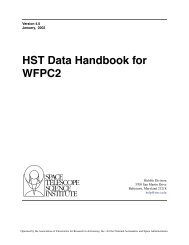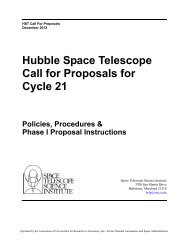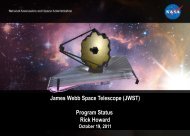STScI Annual Report 2002: A Living Mission
STScI Annual Report 2002: A Living Mission
STScI Annual Report 2002: A Living Mission
Create successful ePaper yourself
Turn your PDF publications into a flip-book with our unique Google optimized e-Paper software.
28 organization<br />
Steven Beckwith<br />
Deputy Director<br />
Michael Hauser<br />
for Science<br />
Bruce Margon<br />
Management<br />
Thomas Lutterbie<br />
Director’s Office [DO]<br />
The DO is responsible for the overall performance of the Institute. � At the current time, the DO performs<br />
five tasks to guide the Institute’s work to achieve the goals of the Strategic Plan: First, it promotes and<br />
protects Hubble’s pace of scientific discovery and potential for the future. Second, it strives to maintain<br />
the scientific integrity of Hubble and the James Webb Space Telescope (JWST) under NASA’s changing<br />
budget constraints. Third, the DO seeks to improve the culture and environment within the Institute at<br />
all levels. Fourth, it ensures that the Institute remains NASA’s choice and the choice of the community<br />
to implement the science and operations of Hubble, JWST, and their successors. Fifth, the DO delegates<br />
authority, instills responsibility, and ensures accountability in the organization. � The Director is the<br />
leader of the Institute and is responsible for its performance to the AURA President, the AURA Board,<br />
NASA, the community of scientific users, and the public. He is the selecting official for time on the<br />
Hubble Space Telescope and the associated grant funding to support scientific research with the data.<br />
He recommends to AURA the promotion of scientists to tenured appointments. He approves budget plans<br />
for the Institute as well as large capital expenditures and use of the discretionary funds. The Director<br />
represents the Institute to the AURA oversight committees—the Space Telescope Institute Council (STIC)<br />
and the Institute Visiting Committee (IVC)—the AURA Board, and the public at large. � The Deputy<br />
Director (DD) serves as Acting Director in the Director’s absence. The DD is responsible for oversight of<br />
the Divisions that directly support the missions: Instruments, Operations and Data Management, and<br />
Engineering and Software Services. The DD presides over regular reviews of the Divisions and their<br />
work plans, and is responsible for ensuring that the staff can meet the commitments of the Institute.<br />
� The Director is the head of the Director’s Office, which includes the Deputy Director, the Associate<br />
Director for Science, the Chief Information Officer, the Head of Program Management, and the Head of<br />
Business Services. � The DO is responsible for leading the Institute. By defining the organization,<br />
strategy, policies, plans, and management team, the DO guides the work of the staff and guarantees the<br />
Institute's commitments to NASA, the scientific community, and the public. The goal of the DO is to make<br />
it easy for everyone to contribute their best capabilities to the Institute’s missions. The DO obtains the<br />
resources needed by the staff to do their work, and it allocates those resources to optimize the productivity<br />
of the Institute. The DO represents the Institute by conducting its external relations, reporting to AURA<br />
and its oversight committees, and receiving guidance from advisory groups.<br />
Associate Director for Science [ADS]<br />
ADS is the Institute’s senior officer for science staffing and science policy. He is responsible for oversight<br />
of the Science Division, Science Policies Division, and the Office of Public Outreach. The ADS<br />
coordinates scientific hiring, renewal, and promotion, and oversees policies applying to the science staff<br />
and their research activities. He acts as a scientific representative of the Institute in initiatives with<br />
other organizations.<br />
Program Management [PM]<br />
The Head of PM is responsible for planning, allocating, and tracking the budgets of the major missions.<br />
The Heads of the Hubble <strong>Mission</strong> Office, JWST <strong>Mission</strong> Office, and Community <strong>Mission</strong>s Office report to<br />
the Head of PM, who works with NASA to establish and maintain the contracts needed to carry out the<br />
Institute’s work. He works with the <strong>Mission</strong> Heads to ensure that their goals for the missions are met<br />
as required by NASA. � The Program Management function comprises groups responsible for financial<br />
and resource management and developing innovative programs throughout the Institute. � The<br />
Resource Management Group leads financial and business planning activities Institute-wide. It prepares<br />
and helps negotiate and administer contract cost proposals, prepares and administers budgets and<br />
staffing plans, and generates government reports such as budget variance analyses. � The Operations<br />
Management Group provides a managerial and programmatic integration between Divisions, <strong>Mission</strong> Offices,<br />
and the DO. It is a focal point for managing staffing and work plans as well as schedules and requirements.<br />
This group's program managers also participate in process improvement activities and lead special<br />
projects, where they promote effective integration, coordination, communication, and conflict resolution.



